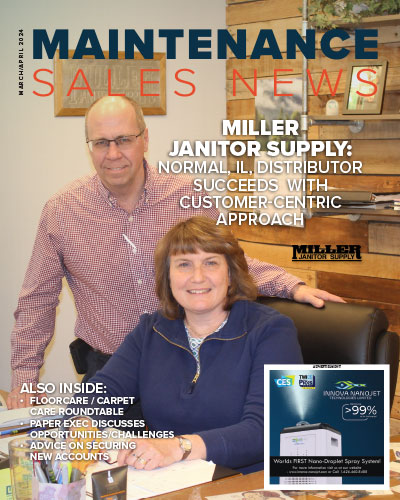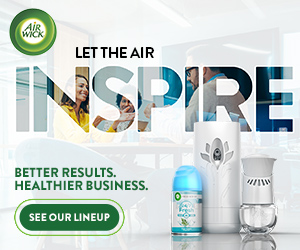MSN Editor Lists 10 Key Products/Systems/Trends In The Cleaning Industry Over Past 40 Years
By Harrell Kerkhoff Maintenance Sales News Editor
In celebration of Maintenance Sales News’ approaching 40th anniversary, I have taken on the task to list, from my own perspective, 10 key products/systems/trends that have made a positive impact on the cleaning industry over the past 40 years. The list does not specify brands, but rather focuses on products/systems/trends that have been instrumental in keeping away-from-home facilities cleaner, and people safer.
The list is in no order of importance:
- Microfiber — According to the Field Research and Consultation Group, Department of Environmental and Occupational Health Sciences at the University of Washington: Microfiber is a polyester and nylon (polyamide) fiber used to make fabric as well as other items. The fiber is split many times smaller than a human hair. That process makes it a superior tool for cleaning and germ removal by penetrating cracks and crevasses. The increased surface area of the fibers and their star shape also allow for the absorption of up to 7 to 8 times their weight in liquid. The fibers generate a static electric charge when moved across a surface that attracts and contains dust, rather than spreading it around or releasing it into the air when dry dusting.
The term microfiber technically applies to fiber that is 1.0 denier or smaller. Manufacturers have created products with different weaves and weave densities for specific tasks. Benefits of microfiber include: effective at capturing microbes; prevents cross-contamination due to the availability of different product colors and a color-coding system; and, reduces chemical and water use during the cleaning process.
- Autonomous Mobile Robots (AMR) floor equipment — According to the Tennant Company, AMR cleaning machines use artificial intelligence (AI) to quickly “learn” a route, without requiring a set track or sensors. Routes can easily be changed at any time, without requiring the re-structuring of the technical hardware for tracks or sensors. This is a significant advantage for such facilities as warehouses that might change layouts frequently. AMR cleaning machines can automatically “see” an obstacle or person — and naturally steer around, continuing cleaning the route. This is a major plus in facilities where downtime is a foreign concept. An autonomous floor scrubber, for instance, can work around pick carts and employees. Cleaning and regular operations can co-exist, without one disrupting or delaying the other.
- Advanced technology for business management, training, inventory control, and product usage monitoring — That includes: ERP (Enterprise Resource Planning) software — which according to Oracle, manages day-to-day business activities such as accounting, procurement, project management, risk management and compliance, as well as supply chain operations. A complete ERP suite also includes enterprise performance management software that helps plan, budget, predict, and report on an organization’s financial results; Learning Management Systems (LMS), which is a software application for the administration, documentation, tracking, reporting, automation, and delivery of educational courses, training programs, materials or learning and development programs, according to Ryann K. Ellis, editor of Learning Circuits (A Field Guide to Learning Management Systems); and, Data-Driven Cleaning, which according to Essity, allows for the use of real-time data to identify when and where there are service needs within a facility to maximize efficiency.
- Green products / importance of sustainability — Name the jan/san product and it’s quite possible there are one or more items in each product category that are now considered “green” and/or can help a business become more sustainable — all in an effort to better protect the environment. That includes floor pads, cleaning chemicals, ice melter and can liners. The list seems endless and continues to grow. What once was considered a “trend” or even a “fad” has become standard fare for many people, companies, and industries.
- High-end ice melters — In more northern climates, properly maintaining facilities from ice and snow hazards — such as parking lots, sidewalks, and steps — is critical. Nobody wants to put on ice skates to enter a building. For years, the use of rock salt was prevalent in helping people stay out of the emergency room due to an icy fall. The problem is rock salt can cause damage to concrete and surrounding vegetation. Today, high-end ice melters are available to help protect facilities from such damage, while being more effective against ice and snow. Some also focus on being friendlier toward the overall environment.
- Entry matting — There is a big reason why entry matts are often present in away-from-home facilities, such as schools, hotels, office buildings and shopping centers — they work well in protecting floors from dirt and grime brought in from the shoes of visitors. According to Proform Entry Matting Systems, entry matting protects floors and reduces maintenance costs, improves indoor air quality, enhances safety by reducing slip-and-fall accidents, and improves the aesthetic appeal and brand image of a facility.
- Hand sanitizers — According to the U.S. Food & Drug Administration (FDA), when it comes to preventing the spread of coronavirus and other infectious diseases, “if soap and water are not readily available, use a hand sanitizer that contains at least 60% alcohol.” Hand-sanitizer dispensers can be found in all types of facilities — from airports and schools to churches and hospital waiting rooms. There are even dispensers designed for outdoor use. Hand sanitizers have proven to be a very quick and easy way to guard against germs, the importance of which grew extensively during the COVID pandemic.
- The emergence of improved disinfectants — If the COVID pandemic proved one thing, it’s important all jan/san distributors and end-users become well versed with the proper use, and the different kinds, of disinfectants. Although the threat of COVID has diminished, the pandemic served as a “good” reminder that pathogen control is a never-ending process. Nothing will shut down a school or other gathering place quicker than an outbreak. All disinfectants, however, require a certain amount of specialized knowledge and training. That includes following label directions and knowing each disinfectant’s dwell time.
In March 2020, the U.S. Environmental Protection Agency released its initial List N: Disinfectants for Use Against SARS-CoV-2. This list began with 85 products and has since grown. The EPA expects all List N products to be effective against SARS-CoV-2 (COVID-19) when used according to label directions. Products qualify for List N if they: Demonstrate efficacy against the coronavirus SARS-CoV-2 (COVID-19); Demonstrate efficacy against a pathogen that is harder to kill than SARS-CoV-2 (COVID-19); or Demonstrate efficacy against a different human coronavirus similar to SARS-CoV-2 (COVID-19).
- Improved air filtration — Another push brought about by the pandemic was the need for safer air. Whether in a building or in a vehicle, the air people breathe is now carefully examined. That focus has resulted in numerous products/systems to filter out pathogens floating around in the air. It includes portable air purification units and advanced air filters, as well as bipolar ionization, germicidal UV-C, ozone, and hydroxyl-generating products.
- Improved battery technology — Battery-powered cleaning equipment, such as sweepers and scrubber machines, continue to be used in great numbers for keeping facility floors safe, clean, and shiny. It involves such products as lithium-ion, flooded lead acid, AGM (absorbent glass mat) and gel batteries. According to ICE Cobotics, the adoption and implementation of new battery technologies in floor care machines continue to revolutionize the floor cleaning industry. This is due to increased operation times resulting in better productivity and efficiency. Longer battery life is directly related to more floor space cleaned in less time. Continued advancements in floor care equipment batteries allow businesses to focus on creating the cleanest environment possible. That includes safer and healthier working environments for a janitorial staff.
This is not a complete list. Many other products and systems have advanced cleaning over the years and serve as a reminder of how important continued innovation is for better product development.








